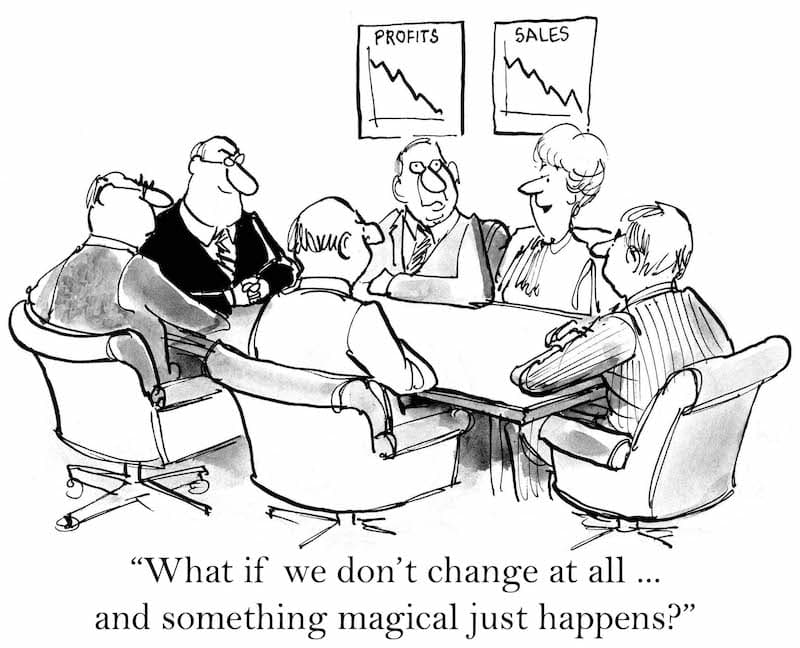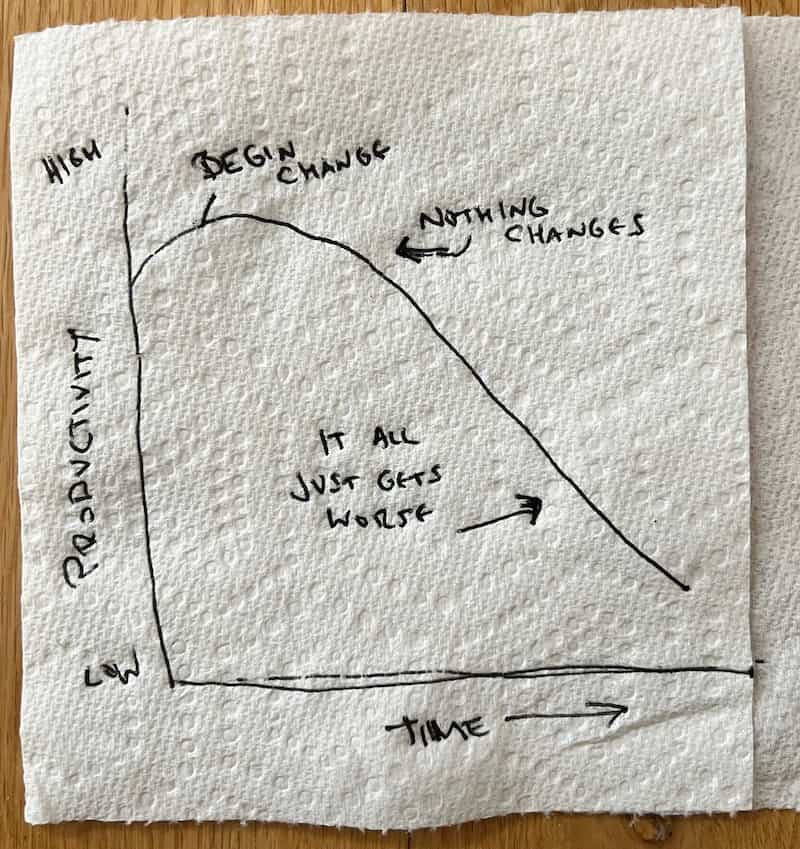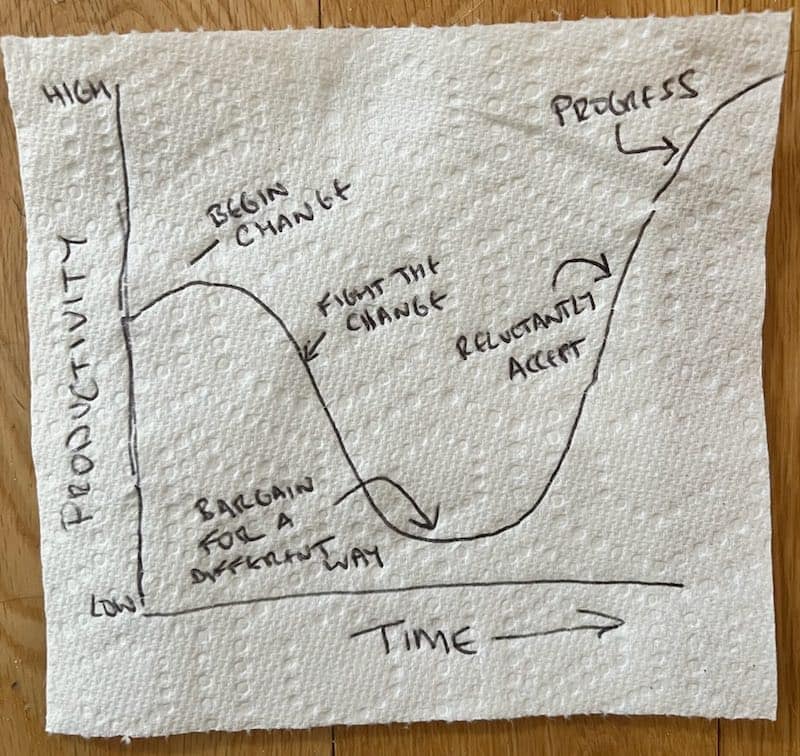Sponsored by… well, me.

Every company encounters moments where transformational change is needed. I help them succeed.
I am giving away my super-secret guide for guaranteed success with transformational change. It’s called:
“How to Implement Transformational Change… That Lasts“

In 1996, social psychologist, Roy Baumeister, used chocolate chip cookies and radishes to prove an important point about human behavior.
Here’s what he did.
He baked homemade chocolate chip cookies and put them in a room, filling up the air with all its freshly baked ooey-gooey aroma. Yum.
He also put in the room a bowl of radishes.
He then brought a group of people into the room who, no doubt, were salivating for some scrumptious, freshly baked cookies.
Truth be told, I’m salivating a bit right now as well.
However, he instructed the subjects that they could NOT eat the cookies. They had to eat the radishes and only the radishes.
Then the researchers left the room.
The group reluctantly ate the radishes. But dag-nubbit if their minds weren’t on the cookies the entire time. I mean, how can you avoid it, what with that welcomingly wafting aroma?!
They looked at the cookies. They talked about the cookies. Some of them even picked up the cookies to smell them. But they all (reluctantly) only ate the radishes.
Roy then put a different group in the room and allowed these new folks to eat the chocolate chip cookies. This group had no problems ignoring the radishes.
All of the subjects were then taken out of the room and asked to solve a logic puzzle (that had nothing to do with cookies or radishes). Roy’s secret was that the puzzle couldn’t actually be solved. What he was trying to determine was how long it would take until each participant gave up.
Here’s what Roy Baumeister found…

What Roy Baumeister Found
The chocolate chip cookie eaters lasted, on average, 19 minutes before they gave up.
The radish eating group, however… they only lasted 8 minutes.
If I were the experimenter, I’d quickly deduce that people who eat chocolate chip cookies are simply smarter humans than others. But I suppose that’s why I’m not an experimenter.
What Roy actually proved with this experiment is the lasting impact of self-control. The radish-eating group required a lot of self-control to avoid eating the cookies. As a result, they had meaningfully reduced patience remaining to solve a problem that required critical thinking.
The cookie eaters, on the other hand, had used no self-control in eating the chocolatey goodness. So they had more patience when it came to problem-solving.
You see where this is going, right?
The Effort of Transformational Change
Humans are hardwired to resist change.
We have a gravitational pull toward our comfort zones. It’s easier there. It’s the happy place.
When we are out of our comfort zone, it requires self-control to counteract the gravitational pull. The further out of our comfort zones, the deeper we must dig into that reservoir of self-control.
As we learned above from the rabbit food and cookie anecdote, the effort required to maintain self-control will reduce our patience and ability to solve problems.
This occurs every day, in more ways than you can even imagine.
Let’s take the child who is patient and gracious and an exemplary student at school, but the moment they come home it’s like they’ve been possessed by the devil.
The kid has to exhibit so much self-control for so long at school, their frustration erupts when they get back into their comfort zone. It’s the radish and the cookies in action.

Transformational Change is Hard
Creating transformational change is hard.
If it were easy, I wouldn’t have any clients.
You see, I am hired by companies and leaders when they are in milestone moments of needing change. I make sure they succeed.
Throughout my career, I’ve seen a whole lot of different companies needing transformational change and I’ve seen a whole lot of leaders prove their ineffectiveness with it.
Heck, I’ve been that ineffective leader in the past as well. Here’s one common scenario that I’ve fallen victim to…
I realized that there was something happening in my company that was far past bad. It could’ve been poor communication, a misaligned team, or ineffective sales – the actual problem is irrelevant.
The point is, I knew we needed to change.
So I spent a lot of time creating a fancy presentation with a new mission statement and core values and tactical roadmaps and pictures, charts, and graphs. I felt great about it. I knew without a doubt that it was our key to success.
One day I gathered all the staff together for a meeting and I went through my presentation with all the zeal and emotional wherewithal I could muster.
It was awesome. I nailed it. And when I finished presenting…
Nothing.
<insert cricket sounds>
“Does anybody have any questions?” I asked.
Nope, not even a murmur.
Nary a mumble.
The meeting ended and I breathed a sigh of relief.
“Whew, that’s done,” I said to my confidante. “I think it went well, right?”
I was looking for justification. Because, as far as I was concerned, my work was over. I described the change we needed, I told everybody how it needed to be done and now I expected it to magically happen.
But it didn’t happen. It never does in those scenarios.
Your Job Is Your Comfort Zone
Does the example above sound familiar to you?
Because it’s the prime example of how transformational change fails to succeed.
People just go back to doing their jobs. Their job is in their comfort zone.
Transformational change requires people to live outside of their comfort zone – to do their job differently. It requires people to be in a room full of cookies yet only eat the radishes.
But given the option, the employees are never going to eat the radishes. They aren’t going to opt for discomfort.
Transformational change doesn’t happen by simply telling people to change.
In fact, here is a stunningly insightful napkin drawing of what happens if you believe transformational change will magically occur simply by verbalizing it.

True, meaningful change – the change that requires proverbially eating radishes – doesn’t happen with jumping joys of eagerness.
Transformational change actually includes a dip in productivity and more than a fair share of dismay before catapulting to success. Here is my beautifully intricate drawing of what the process of transformational change normally looks like when done successfully (and drawn on the backside of the napkin in the photo above):

There is a five-step process I follow that guarantees success in moments of transformational change.
If you’re interested in learning how to succeed with transformational change, you can download the framework here:
Download “How To Implement Transformational Change… that Lasts!”
In the meantime, remember that truly making transformational change is like eating radishes in a room full of cookies – it’s not always what you want, but it’s what you need.
A Somewhat Relevant Quote
“Change is inevitable. Growth is optional.“
John C. Mawell, author, speaker, owner of a very purple website
Random News
Kayak Attack – When your fishing boat looks like lunch
The Happy War – The 6th happiest country fired upon the 7th
Lost Child – I’m not sure which part of this is the most disturbing
Future DA – A girl requested DNA proof of Santa Claus
